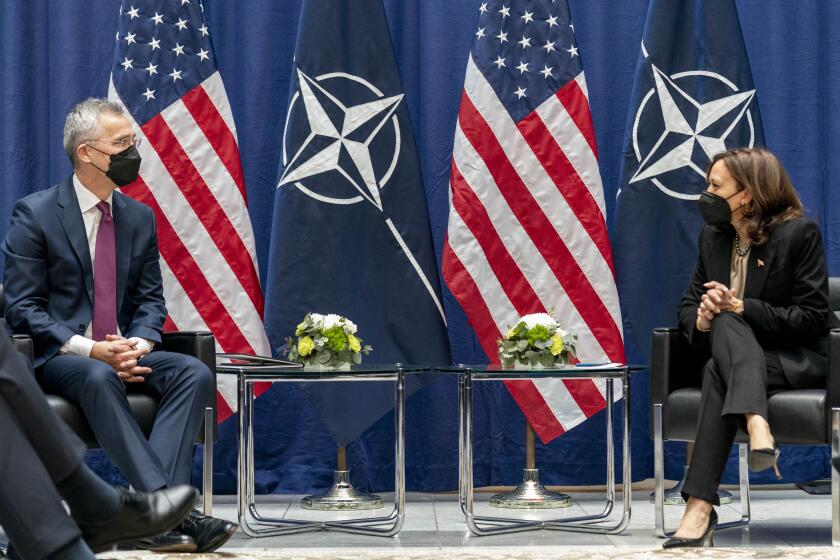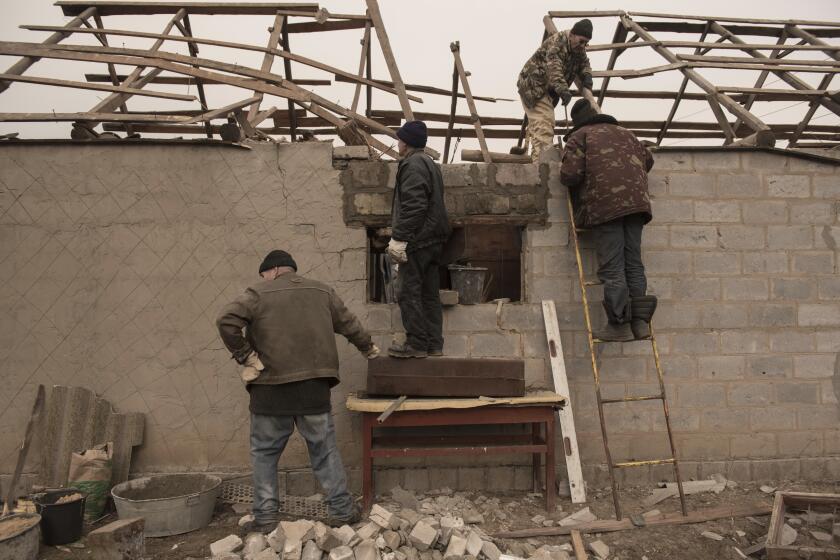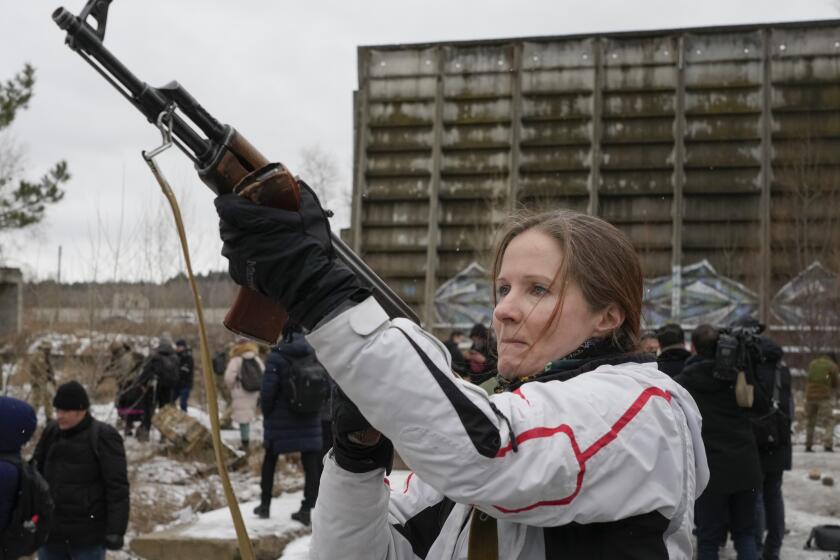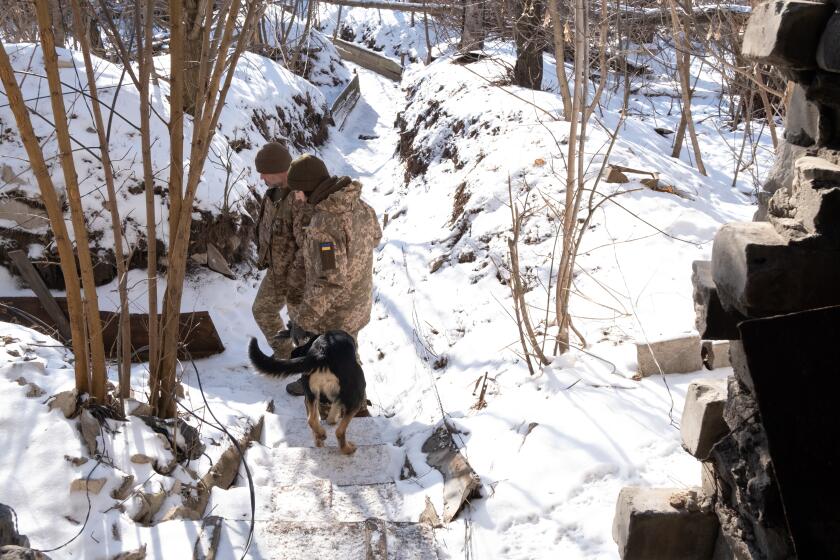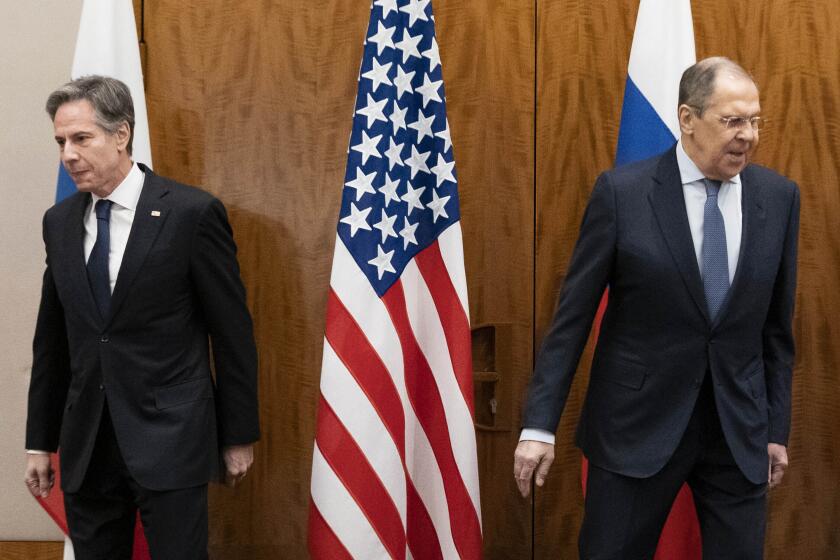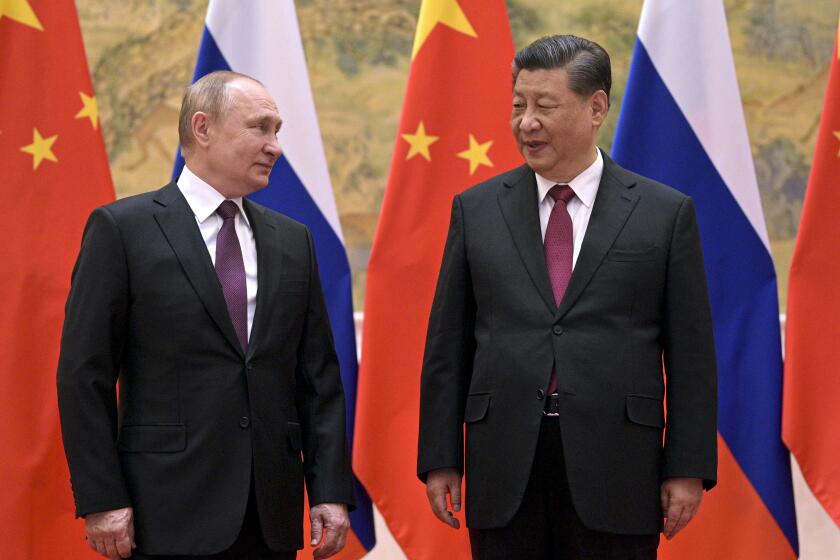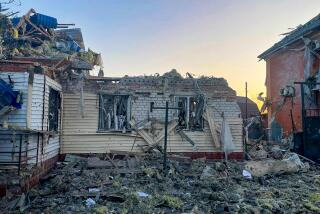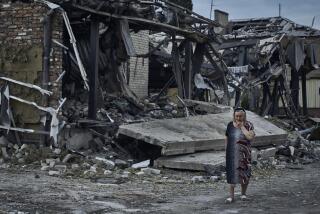Ukrainian rebels evacuate civilians to Russia as tensions escalate

- Share via
KYIV, Ukraine — Spiking tensions in eastern Ukraine on Friday aggravated Western fears of a Russian invasion and a new war in Europe, with a humanitarian aid convoy hit by shelling and pro-Russia rebels evacuating civilians from the conflict zone. A car bombing hit the eastern city of Donetsk, but no casualties were reported.
The Kremlin declared massive nuclear drills to flex its military muscle, and Russian President Vladimir Putin pledged to protect his country’s national interests against what he sees as encroaching Western threats. U.S. and European leaders grasped for ways to keep the peace and Europe’s post-Cold War security order.
While Putin held out the possibility of diplomacy, a cascade of developments this week has further exacerbated East-West tensions and fueled war worries. U.S. and European officials, focused on an estimated 150,000 Russian troops posted around Ukraine’s borders, warn that the long-simmering separatist conflict in eastern Ukraine could provide the spark for a broader attack.
Vice President Kamala Harris said the U.S. still hoped Russia would de-escalate but was ready to hit it with tough sanctions in case of an attack. U.S. leaders this week issued their most dire warnings yet that Moscow could order an invasion of Ukraine any day.
“We remain, of course, open to and desirous of diplomacy ... but we are also committed, if Russia takes aggressive action, to ensure there will be severe consequence,” Harris said at the annual Munich Security Conference in Germany.
While Russia skipped this year’s conference, lines of communication remain open. The U.S. and Russian defense chiefs spoke Friday, with U.S. Defense Secretary Lloyd J. Austin III calling for de-escalation, the return of Russian forces surrounding Ukraine to their home bases and a diplomatic resolution, according to the Pentagon. Secretary of State Antony J. Blinken and Russian Foreign Minister Sergei Lavrov have agreed to meet next week.
President Biden said he believes Putin has made up his mind to invade Ukraine and warned of Russians engaging in disinformation to create a pretext for war.
Immediate worries focused on eastern Ukraine, where Ukrainian forces have been fighting pro-Russia rebels since 2014 in a conflict that has killed some 14,000 people.
A bombing struck a car outside the main government building in Donetsk, a major city in the east, according to an Associated Press journalist there. The head of the separatists’ forces, Denis Sinenkov, said the car was his, the Interfax news agency reported.
There were no reports of casualties and no independent confirmation of the circumstances of the blast. Uniformed men inspected the burned-out car. Broken glass littered the area.
Shelling and shooting are common along the line that separates Ukrainian forces and the rebels, but targeted violence is unusual in rebel-held cities such as Donetsk.
However, the explosion and the announced evacuations were in line with U.S. warnings of so-called false-flag attacks that Russia would use to justify an invasion.
Separatists in the Luhansk and Donetsk regions, which form Ukraine’s industrial Donbas heartland, said they were evacuating civilians to Russia. The announcement appeared to be part of Moscow’s efforts to counter Western warnings of a Russian invasion and to paint Ukraine as the aggressor.
Denish Pushilin, the head of the breakaway government in the Donetsk region, said that women, children and elderly people would be evacuated first, and that Russia had prepared facilities to accommodate them. Pushilin alleged in a video statement that Ukrainian President Volodymyr Zelensky was going to order an offensive in the area.
False images and narratives of Ukrainian atrocities and other allegations have been spread by Russia-aligned media and digital actors.
Metadata from two videos posted by the separatists announcing the evacuation show that the files were created two days ago, the Associated Press confirmed. U.S. authorities have alleged that Kremlin plans included prerecorded videos as part of a disinformation campaign.
Authorities began moving children from an orphanage in Donetsk, and other residents boarded buses for Russia. Long lines formed at gas stations as more people prepared to leave on their own.
Putin ordered his emergencies minister to fly to Russia’s Rostov region, bordering Ukraine, to help organize the exodus and ordered the government to offer a payment of 10,000 rubles — about $130 — to each evacuee, equivalent to about half the average monthly salary in war-ravaged Donbas.
Ukraine denied planning any offensive, with Foreign Minister Dmytro Kuleba saying, “Ukraine does not conduct or plan any such actions in the Donbas.”
“We are fully committed to diplomatic conflict resolution only,” he tweeted.
Plenty of residents of Kyiv don’t seem to think their capital is on borrowed time, but some are girding for a potential Russian invasion anyway.
Around the volatile “line of contact” in eastern Ukraine, a United Nations convoy came under rebel shelling in the Luhansk region, Ukraine’s military chief said. No casualties were reported. Rebels denied involvement and accused Ukraine of staging a provocation.
Separatist authorities reported more shelling by Ukrainian forces along the line, though their claims could not be verified. Kremlin spokesman Dmitry Peskov said the situation was “potentially very dangerous.” A surge of shelling Thursday tore through the walls of a kindergarten, and basic communications were disrupted. Each side accused the other of opening fire.
U.S. and European officials are on high alert for any Russian attempts at a false-flag operation, according to a Western official familiar with intelligence findings. Ukrainian government officials shared intelligence with allies that suggested the Russians might try to shell the areas in the eastern Luhansk region controlled by Moscow-backed separatists as part of an effort to contrive a reason to take military action, according to the official, who was not authorized to comment publicly.
United Nations Secretary-General Antonio Guterres said the threat to global security is “more complex and probably higher” than during the Cold War. He said at the Munich conference that a small mistake or miscommunication between major powers could have catastrophic consequences.
Slog of trench warfare in eastern Ukraine yields scenes reminiscent of World War I.
Although Russia announced this week that it was pulling back some forces from vast military exercises that had sparked fears of an invasion, U.S. officials said they saw no signs of such a withdrawal, but rather more troops being moved in.
The White House formally accused Russia of being responsible for recent cyberattacks targeting Ukraine’s Defense Ministry and major banks. The announcement was the most pointed attribution of responsibility for the cyber intrusions.
Also Friday, the U.S. government released new estimates of the size of Russian forces in and around Ukraine. It said there are between 169,000 and 190,000 troops, up from about 100,000 on Jan. 30, according to Michael Carpenter, the permanent U.S. representative to the Organization for Security and Cooperation in Europe, known as OSCE.
The new estimate includes forces along the border, in Belarus and in occupied Crimea; Russian national guard and other internal security units deployed to these areas; and Russian-backed forces in eastern Ukraine. The separatists inside Ukraine, the Russian national guard and troops in Crimea were not included in the previous U.S. estimate of 150,000.
The Kremlin sent a reminder to the world of its nuclear might, announcing drills of its nuclear forces this weekend. Putin will monitor the sweeping exercise Saturday that is to involve multiple practice missile launches.
The move overshadowed Russian offers of continued diplomacy to defuse the Ukraine crisis.
While the Kremlin insists it has no plans to invade Ukraine, it has urged the West to keep Ukraine out of NATO and roll back alliance forces from Eastern Europe — demands roundly rejected by Western allies.
The Russia-Ukraine crisis offers a lesson: The U.S. is still a superpower, but its ability to influence events overseas is increasingly limited.
Asked about Western warnings of a possible Russian invasion Wednesday that didn’t materialize, Putin said, “Frankly, I’m not paying attention to that. There are so many false claims, and constantly reacting to them is more trouble than it’s worth.
“We are doing what we consider necessary and will keep doing so,” he said. “We have clear and precise goals conforming to national interests.”
Putin reaffirmed that Russia was open for dialogue on confidence-building measures with the West on condition that they be discussed in conjunction with Moscow’s main security demands.
News Alerts
Get breaking news, investigations, analysis and more signature journalism from the Los Angeles Times in your inbox.
You may occasionally receive promotional content from the Los Angeles Times.
NATO allies are also flexing their might, beefing up forces around Eastern Europe, but contend that their actions are purely defensive and meant to show unity in the face of Russian threats.
The U.S. announced the $6-billion sale of 250 tanks to Poland, a NATO member that has been occupied or attacked by Russia in previous centuries.
Perhaps his new enthusiasm for diplomacy last week meant Putin isn’t bent on war after all.
More to Read
Sign up for Essential California
The most important California stories and recommendations in your inbox every morning.
You may occasionally receive promotional content from the Los Angeles Times.
